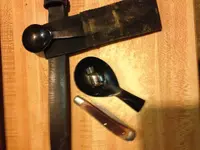This is what Oroblanco told me.
Still looking for his pictures.
I have permission.
Sure Matt - you put no more than a HALF spoon of dirt in the spoon, with enough water to cover it; having removed all the larger rocks before. Mix it with a finger or small stick, and then shake it (lightly!) from side to side for a bit. Then dip the spoon in a bowl or larger spoon of water, and tipping it up toward you as if you are trying to slide the contents off away from you, pull it up out of the water. Repeat the process as each time you dip and remove the spoon, some lighter dirt should be washing over the edge, leaving the black sand and gold (hopefully there is gold in it anyway). It is the same process as gold panning but you are only using one hand to pan, the other has a bowl or larger spoon or can etc with more water so as to remove the lighter stuff. Once you try it, you will be surprised at how well it works!
To cut the horn lengthwise, do it so that the curve is down, the point and base up; the upper half then is not used (there are other uses for cut horn) just the lower curved part, which is like a shallow elongated bowl. You can then use it as a mini gold pan. Horn may look shiny but is a very fibrous material so the tiniest gold particles tend to stick to it, making it easier for you to spot it. I would recommend getting a black horn if possible as the gold stands out better than on a light colored or grey horn. "Horning" for gold is a very old, old timers trick, dates to before the Roman times.






